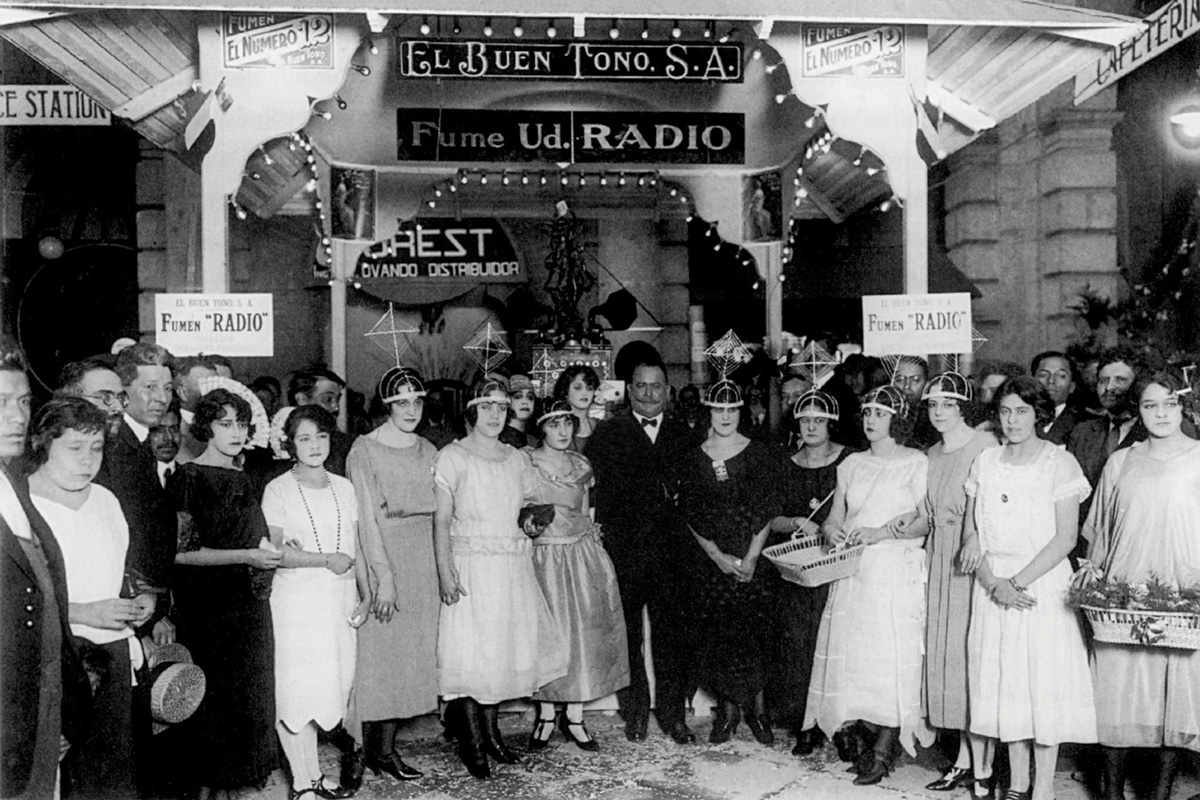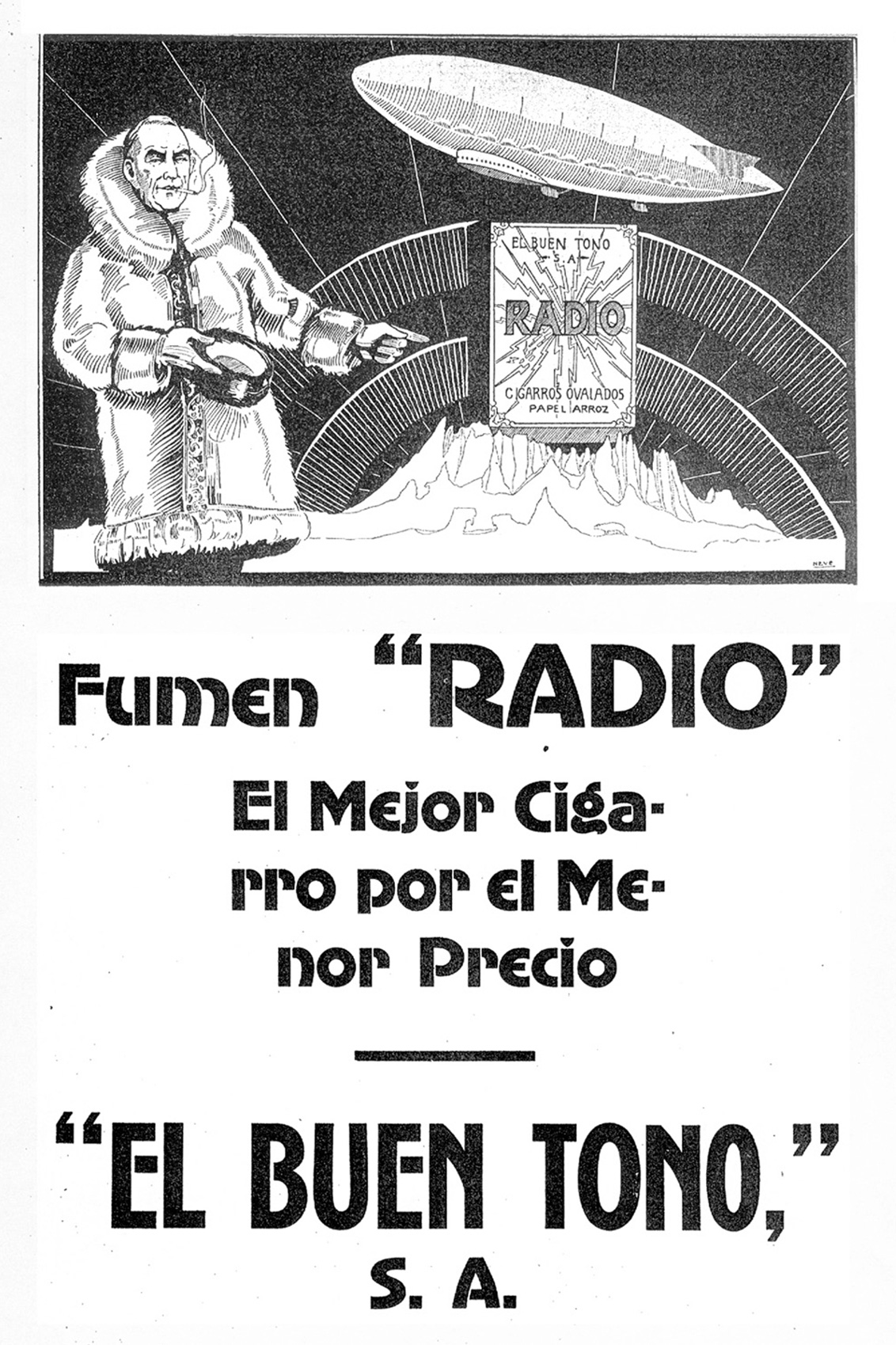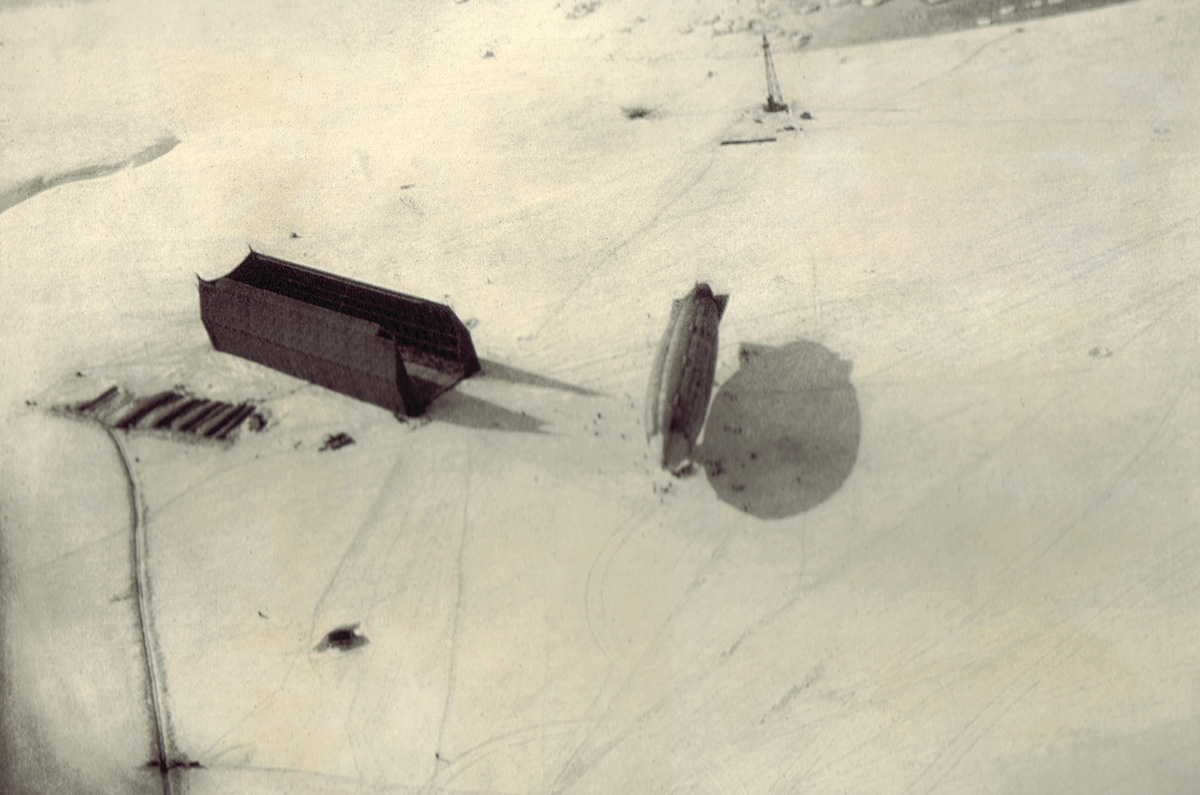Mexican Radio Goes to the North Pole
Tobacco’s wireless adventures
Rubén Gallo

When wireless broadcasting began in the 1920s, artists and writers around the world were gripped by what some historians have called “the madness of radio.” A frenzy for the new technology seized enthusiasts from Paris to Mexico City and led to some outrageous tales: a Chicago doctor believed newborns could be educated by being wired to receivers, and a Mexican poet proposed designing miniature earphones for parrots in order to spare their owners the trouble of teaching them to talk. But of all the mad wireless projects from the 1920s, one stands out for its fantastic twists and turns: the story of El Buen Tono, Mexico’s largest tobacco company, which in 1923 opened its own broadcasting station and launched a series of campaigns that would be more at home in a Futurist story by Velimir Khlebnikov than in the headquarters of a cigar manufacturer.[1]
El Buen Tono was owned by Ernest Pugibet, a French immigrant with a fetish for technology who was obsessed with linking his company to the most modern inventions. He already owned a blimp and a hot air balloon that navigated the skies of Mexico City promoting the virtues of smoking Buen Tono cigarettes, and could not resist allying his company with one of the sexiest and most mysterious inventions of the modern era. Pugibet might have suspected that there was something incongruous about a tobacco company’s decision to launch a radio station, so he decided to make his project seem more logical by launching a new brand of cigarettes called “Radio.” A photograph of El Buen Tono’s stand at Mexico City’s 1923 radio fair shows a proud Pugibet standing in front of an enormous radio receiver, surrounded by banners urging visitors to “Smoke Radio.” To give visitors a taste of the future, the women who tended the booth wore radio antennas on their heads and carried baskets full of Radio cigarettes. And while their radio hats were not sophisticated enough to catch radio programs, the women-antennas were extremely successful at catching potential customers for El Buen Tono, at least if we are to judge from the crowds gathered at the company’s stand.
El Buen Tono was not the only company hoping to capitalize on radio’s desirability as a novel technology—in the same years, for example, Cervecería Moctezuma introduced a “radiophonic beer”—but El Buen Tono certainly outdid its competitors when it came to creative advertising. At one point, the tobacco company realized that not many Mexicans had radio receivers, so it decided to launch a new campaign focused on exchanging empty cigarette packs for radio parts: three for a pack of batteries; fourteen for a pair of earphones; twenty for a “Ritter set” receiver.
The most intriguing—and puzzling—advertisement was one for Radio cigarettes published in a literary journal called El Universal Ilustrado. The ad was similar to others in which the company had urged consumers to “smoke Radio,” but this time the caption appeared under a most unusual image: the pack of Radio cigarettes appeared over what looked like an iceberg, was crowned by a giant blimp, and flanked by a man wearing a fur coat and smoking a cigarette.

Who was this Nordic-looking man and why was he promoting El Buen Tono’s cigarettes? Why would a Mexican tobacco company choose an icy landscape as the backdrop for a product that was grown in the tropics? And what was the connection between radio and the blimp, another invention of the modern era that fascinated Ernest Pugibet? Looking through newspapers from 1926—the year the ad was first published—I was able to uncover a tale that was even more bizarre and even more fantastic than the android cigarette sellers or the radiophonic beer. It turns out the advertisement had to do with a news item that was the talk of the town in Mexico City during the summer of 1926.
In the first days of May of that year, the Norwegian explorer Roald Amundsen, a seasoned adventurer who had been the first man to reach the South Pole, set out on an ambitious expedition to the North Pole. This time he did not board a ship or fly an airplane, as he had done in previous journeys, but settled for a means of transportation that was as implausible as his itinerary: an enormous zeppelin, almost 350 feet long, which he patriotically called the Norge. Amundsen explained that a hydrogen-filled dirigible had many advantages over an airplane. “An airship,” he wrote in an account of his expedition, “floats in the air even if all the motors should fail.”
Amundsen’s zeppelin, equipped with a large crew that included mechanics, radio telegraphists, and weather observers, departed from Spitsbergen in northern Norway, and embarked on a route that was to take it across the Polar Sea, over the North Pole (“the top of the world,” as the explorer called it in his journals), and down the other side of the globe to Alaska. The logistics of the trip were extraordinarily complex: since there were no dirigible repair facilities in the Arctic, Amundsen took the precaution of shipping elaborate kits, composed of hundreds of spare parts, to every scheduled stop along his route. And to keep in touch with the world below, he had a powerful radio apparatus installed aboard the blimp, a floating station capable of sending and receiving meteorological forecasts, travel details, and a time signal.
Against all odds, Amundsen’s journey was a success. He reached the North Pole on 12 May 1926 and immediately ran to the Norge’s Marconi room to send a radio telegram announcing the good news. The message, written in abbreviated, run-on language reminiscent of Marinetti’s “words-in-freedom” and other avant-garde poetry, conveys the excitement felt by the explorer: “WHEN NORGE OVER NORTH POLE WAS GREATEST OF ALL EVENTS THIS FLIGHT,” and even offers a brief but compelling description of the polar landscape: “ICY WASTES WHOSE EDGES GLEAMED LIKE GOLD IN THE PALE SUNLIGHT BREAKING THROUGH FOG WHICH SURROUNDED US STOP.”
When Amundsen landed safely in Alaska as scheduled, he instantly became a celebrity: reports about his journey were broadcast by radio around the world, and photographs of him appeared on the front pages of every major newspaper from Moscow to Buenos Aires. In Mexico City, accounts of the Norwegian’s feat dominated the press during the summer of 1926. Photos of Amundsen and his zeppelin appeared almost daily in the city’s most prominent publications, from Revista de Revistas to El Universal Ilustrado. Excélsior, the country’s most important newspaper, serialized Amundsen’s travel journal and proudly announced to its readers that the text had been sent wirelessly from the United States—where Amundsen was spending a few days before returning to Scandinavia—by “direct radiogram, exclusively for Excélsior.”[2] The paper’s New York correspondent even secured an exclusive interview with the explorer that appeared on the front page on 4 July 1926.
Part of the reason the Mexican press was so interested in Amundsen had to do with a freak incident of radio transmission: as the explorer reached the North Pole, he tuned his onboard receiver and happened upon a program sent into the airwaves by El Buen Tono’s station, which had recently acquired a powerful shortwave transmitter. The incident, reports radio historian Jorge Mejía Prieto, “became one of [the radio station’s] greatest points of pride,”[3] and inspired the image of Amundsen on the North Pole, standing under his zeppelin and pointing to a box of Radio cigarettes and smoking. The ad copy—“Smoke ‘Radio’”—urges readers to follow suit.
For El Buen Tono, the news about Amundsen’s polar reception was a dream come true. As is clear from its ad campaigns, the company was out to modernize Mexico one citizen at a time, turning every smoker—and by extension every Mexican—into a radio listener fully attuned to the sounds of modernity. By smoking Radio and listening to our station, the ads seem to reason, every Mexican will become a modern subject. And could there be a more perfect model for this ideal than Roald Amundsen? The Norwegian was an archetypal modern man: he traveled in flying machines, crisscrossed the world with the ease of Hertzian waves, and he listened to the radio—not just to any radio, but to El Buen Tono’s sparkling, modern shortwave broadcasts. The tobacco company hoped not only to turn every smoker into a radio listener, but every Mexican into an Amundsen.

Curiously, though most radio histories point to Amundsen’s polar reception as one of the highlights of Mexican broadcasting, none of the historians provides more details about the fantastic event. What exactly did Amundsen hear on the radio? How did he identify the source station? When did he contact El Buen Tono and what did he tell the station? Since the answers were nowhere to be found in the scant publications on the subject, in August 2004 I embarked on an expedition to the Mexico City archives determined to uncover the entire story.
My first stop was El Buen Tono’s radio station, which is, surprisingly, still on the air and operating on the same frequency as in the 1920s, although it is no longer owned by the tobacco company. Once inside the offices, my inquiries about the North Pole broadcast were met with blank looks and a slight suspicion, not entirely unfounded, that I too was afflicted with the “madness of radio.” No one there had ever heard about Amundsen, but the manager invited me to tell the Norwegian’s strange story on the air instead.
My next stop was the newspaper archive at UNAM, the National University, where I scoured past issues of Excélsior in search of more details. This time I had better luck, and I was able to find the puzzle’s missing pieces and correct the record on the explorer’s Mexican connection. Amundsen, it turns out, did not really hear Mexican radio on the North Pole. What really happened was this:
In mid-June 1926, after the news of Amundsen’s expedition had been featured on Excélsior’s front page almost every day for weeks, El Buen Tono seized the occasion to promote its cigarettes. The company launched a new ad for Radio cigarettes showing Amundsen at the North Pole and announcing “Amudsen [sic] has said it: the true conquerors of the North Pole are El Buen Tono’s ‘Radio’ cigarettes. El Buen Tono, the company of world-wide fame.”[4] These were the days before truth in advertising, and a week later the cigar manufacturer launched an even more daring ad featuring the same image of Amundsen smoking on the North Pole: “The first thing Amundsen did as he flew over the North Pole was to smoke a ‘Radio’ cigarette: the cigarettes famous throughout the globe.” The ever-cautious and safety-obsessed Norwegian explorer would have certainly been horrified at this scene of recklessness: a lit cigarette could have blown the Norge to a million pieces!
It appears that years later, when browsing through archival clippings, El Buen Tono’s managers took the ad copy literally, and spread the word that the explorer had indeed said what the spreads claim him to have said. There was a curious slippage from smoking to listening, from cigarette consumption to radio tuning, and thus the image of Amundsen smoking Radio was read as proof that the explorer had listened to El Buen Tono’s radio station. This misreading of Amundsen’s polar reception eventually found its way into Mejía Prieto’s Historia de la radio y la televisión en México, and his account was later repeated verbatim by other historians.
El Buen Tono’s radio signal never reached the explorer, but the Radio campaign effectively brought Amundsen to Mexico. Though in real life the explorer never visited, the ad campaign transported him to Mexico, at least symbolically, since his name and photograph were delivered to every Mexican family that subscribed to Excélsior. In July 1926, the newspaper reported that a group of local enthusiasts had invited the Norwegian to visit Mexico and give a series of lectures about Arctic travel, but the explorer politely declined. He told a reporter that he was too exhausted from his polar trip and simply wanted to go back to Norway and get some rest. In any case, “the explorer,” the newspaper concluded, “was very pleased to hear that he was well-known in Mexico, and he expressed gratitude for the praiseworthy reports of their deeds published in Excélsior.”[5] Amundsen, it seems, was only drawn to icy corners of the planet—the Antarctic, the North Pole, Norway—and had little use for a tropical country like Mexico.
The explorer’s Mexican fans were not discouraged by this lack of interest, and they continued to celebrate his prowess until after his death. When Amundsen lost his life in 1928—he vanished in the Arctic as he was flying to rescue a fellow explorer from a dirigible crash—two prestigious learned societies in Mexico City organized an elaborate homage to his life and deeds. The proceedings were published in a booklet titled Sesión solemne en homenaje al ilustre explorador de los polos Roald Amundsen. The meeting was attended by over one hundred Mexican scientists, and featured a keynote speech on Amundsen’s explorations by Agustín Aragón, who extolled the Norwegian as a “model citizen,” a “tireless lover of ice,” and compared his heroic adventures to those of Don Quixote and the Spanish conquistadors. “May Roald Amundsen rest in peace,” one of the orators concluded, “and may History write his name in characters that will be remembered for all eternity for his virtuous and generous deeds.”[6]
The story of Amundsen tuning in to Mexican radio over the North Pole turned out to be merely a clever advertising ploy devised by El Buen Tono, nothing more than a fantasy full of cigarette smoke and mirrors. But fantasies—as Freud demonstrated in his discussions of dreams, slips of the tongue, and other parapraxes—can tell us a great deal since they almost invariably represent “the fulfillment of a wish.” It is easy to see what wish was being fulfilled in El Buen Tono’s fantasy about its radio station: that Mexico, a country that during the Revolution had become increasingly isolated and cut off from the rest of the world, could finally take its place among the community of modern nations. The whole world was talking about Amundsen’s feat, and the cigarette manufacturer’s claims allowed Mexico—and El Buen Tono—to share center stage with the Norwegian explorer. During a time marked by great expectations, the company’s radiophonic fantasy propelled Mexico, a poor country recovering from a devastating civil war, from the margins to the “top of the world.”
- For more on “the madness of radio,” see the chapter titled “Radio” in my Mexican Modernity: the Avant-Garde and the Technological Revolution (Cambridge, MA: MIT Press, 2005).
- Excélsior, 6 June 1926.
- Jorge Mejía Prieto, Historia de la radio y la televisión en México (Mexico City: Octavio Colmenares Editor, 1972), p. 34. This episode is repeated verbatim in Gloria Fuentes, La radiodifusión (Mexico City: Secretaría de Comunicaciones y Transportes, 1987), p. 71, and is also mentioned in Fernando Mejía Barquera, La industria de la radio y la televisión, vol. 1 (Mexico City: Fundación Manuel Buendía A.C., 1989), p. 26.
- Excélsior, 18 June 1926.
- “Amundsen y Byrd hacen elogios de Excélsior,” Excélsior, 4 July 1924.
- Sesión solemne en homenaje al ilustre explorador de los polos Roald Amundsen (Mexico City: Sociedad Mexicana de Geografía y Estadística, 1928), p. 135.
Rubén Gallo is the author of Mexican Modernity: The Avant-Garde and the Technological Revolution (MIT Press, 2005) and New Tendencies in Mexican Art: The 1990s (Palgrave, 2004). He edited The Mexico City Reader (University of Wisconsin Press, 2004) and teaches literature and cultural studies at Princeton University.